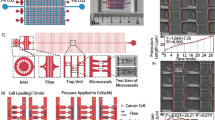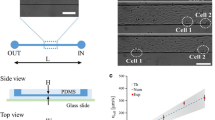Abstract
Introduction
Distant spreading of primary lesions is modulated by the vascular dynamics of circulating tumor cells (CTCs) and their ability to establish metastatic niches. While the mechanisms regulating CTC homing in specific tissues are yet to be elucidated, it is well documented that CTCs possess different size, biological properties and deformability.
Methods
A computational model is presented to predict the vascular transport and adhesion of CTCs in whole blood. A Lattice–Boltzmann method, which is employed to solve the Navier-Stokes equation for the plasma flow, is coupled with an Immersed Boundary Method.
Results
The vascular dynamics of a CTC is assessed in large and small microcapillaries. The CTC shear modulus \({k}_{\text{ctc}}\) is varied returning CTCs that are stiffer, softer and equally deformable as compared to RBCs. In large microcapillaries, soft CTCs behave similarly to RBCs and move away from the vessel walls; whereas rigid CTCs are pushed laterally by the fast moving RBCs and interact with the vessel walls. Three adhesion behaviors are observed—firm adhesion, rolling and crawling over the vessel walls—depending on the CTC stiffness. On the contrary, in small microcapillaries, rigid CTCs are pushed downstream by a compact train of RBCs and cannot establish any firm interaction with the vessel walls; whereas soft CTCs are squeezed between the vessel wall and the RBC train and rapidly establish firm adhesion.
Conclusions
These findings document the relevance of cell deformability in CTC vascular adhesion and provide insights on the mechanisms regulating metastasis formation in different vascular districts.









Similar content being viewed by others
References
Bagnall, J.S., Byun, S., Begum, S., Miyamoto, D.T., Hecht, V.C., Maheswaran, S., Stott, S.L., Toner, M., Hynes, R.O., Manalis, S.R.: Deformability of tumor cells vs. blood cells. Sci Rep 5, 18542 (2015)
Coclite, A., Mollica, H., Ranaldo, S., Pascazio, G., de Tullio, M.D., Decuzzi, P.: Predicting different adhesive regimens of circulating particles at blood capillary walls. Microfluidics and Nanofluidics 21(11), 168 (2017)
Cross, S.E., Jin, Y.S., Rao, J., Gimzewski, J.K.: Nanomechanical analysis of cells from cancer patients. Nat Nanotechnol 2, 780–3 (2007)
Falcucci, G., Ubertini, S., Chiappini, D., Succi, S.: Modern lattice boltzmann methods for multiphase microflows. IMA Journal of Applied Mathematics 76(5), 712–725 (2011)
Fedosov, D., Caswell, B., Karniadakis, G.: A multiscale red blood cell model with accurate mechanics. Biophysical Journal 98(10), 2215–2225 (2010)
Fedosov, D., Caswell, B., Popel, A., Karniadakis, G.: Blood flow and cell-free layer in microvessels. Microcirculation 17(8), 615–628 (2010)
Fedosov, D., Gompper, G.: White blood cell margination in microcirculation. Soft Matter 10(8), 2961–70 (2014)
Fedosov, D., Peltmäki, M., Gompper, G.: Deformation and dynamics of red blood cells in flow through cylindrical microchannels. Soft Matter 10(24), 4258–67 (2014)
Gekle, S.: Strongly accelerated margination of active particles in blood flow. Biophysical Journal 110(2), 514 – 520 (2016)
Guz, N., Dokukin, M., Kalaparthi, V., Sokolov, I.: If cell mechanics can be described by elastic modulus: Study of different models and probes used in indentation experiments. Biophysical Journal 107, 564–575 (2014)
Hammer, D.A., Apte, S.: Simulation of cell rolling and adhesion on surfaces in shear flow: general results and analysis of selectin-mediated neutrophil adhesion. Biophys. J. 63(1), 35–57 (1992)
Joyce, J.A., Pollard, J.W.: Microenvironmental regulation of metastasis. Nat. Rev. Cancer 9(4), 239–252 (2009)
King, M., Hammer, D.A.: Multiparticle adhesive dynamics: Hydrodynamic recruitment of rolling leukocytes. Proc. Natl. Acad. Sci. U.S.A. 98(26), 14919 – 14924 (2001)
King, M., Phillips, K., Mitrugno, A., Lee, T., de Guillebon, A., McGuire, S.C., Carr, R., Baker-Groberg, S., Riggand, R., Kolatkar, A., Luttgen, M., Bethel, K., Kuhn, P., Decuzzi, P., McCarty, O.: A physical sciences network characterization of circulating tumor cell aggregate transport. Am. J. Physiol. Cell Physiol. 308(10), C792–C802 (2015)
Krastev, V.K., Falcucci, G.: Simulating engineering flows through complex porous media via the lattice Boltzmann method. Energies 11(4), 715 (2018)
Krüger, T.: Effect of tube diameter and capillary number on platelet margination and near-wall dynamics. Rheol. Acta. 55(6), 511–526 (2016)
Krüger T, Raabe, D.: Efficient and accurate simulations of deformable particles immersed in a fluid using a combined immersed boundary Lattice Boltzmann finite element method. Comput. Math. Appl. 61(12), 3485–3505 (2011)
Lac, E., Barthes-Biesel, D., Pelekasis, N., Tsamopoulos, J.: Spherical capsuls in three- dimensional unbounded stokes flow: Effect of the membrane constitutive law and onset of buckling. Journal of Fluid Mechanics 516, 303–334 (2004)
Lee, T.R., Choi, M., Kopacz, A., Yun, S.H., Liu, W., Decuzzi, P.: On the near-wall accumulation of injectable particles in the microcirculation: smaller is not better. Sci. Rep. 3, 2079 (2013)
Lekka, M., Laidler, P., Gil, D., Lekki, J., Stachura, Z., Hrynkiewicz, A.Z.: Elasticity of normal and cancerous human bladder cells studied by scanning force microscopy. Eur Biophys J 28, 312–6 (1999)
Li, J., Dao, M., Lim, C.T., Suresh, S.: Spectrin-level modeling of the cytoskeleton and optical tweezers stretching of the erythrocyte. Biophysical Journal 88(1), 3707–3719 (2005)
Li, Y., Stroberg, W., Lee, T.R., Kim, H., Man, H., Ho, D., Decuzzi, P., Liu, W.: Multiscale modeling and uncertainty quantification in nanoparticle-mediated drug/gene delivery. Computational Mechanics 53, 511–537 (2014)
Maeda, N., Suzuki, Y., Tanaka, J., Tateishi, N.: Erythrocyte flow and elasticity of microvessels evaluated by marginal cell-free layer and flow resistance. Am J Physiol. 516(6), H2454–H2461 (1996)
McWhirter, J., Noguchi, H., Gompper, G.: Nonlinear elastic and viscoelastic deformation of the human red blood cell with optical tweezers. Proceedings of the National Academy of Sciences of the United States of America 106(15), 6039–6043 (2009)
Mendez, S., Gibaud, E., Nicoud, F.: An unstructured solver for simulations of deformable particles in flows at arbitrary reynolds numbers. Journal of Computational Physics 256(1), 465–483 (2014)
Mills, J., Qie, L., Dao, M., Lim, C., Suresh, S.: Nonlinear elastic and viscoelastic deformation of the human red blood cell with optical tweezers. Mech Chem Biosyst 1(3), 169–180 (2004)
Mody, N.A., Lomakin, O., Doggett, T.A., Diacovo, T.G., King, M.R.: Mechanics of transient platelet adhesion to von willebrand factor under flow. Biophys. J. 88(2), 1432–1443 (2005)
Mollica, H., Coclite, C., Miali, M., Pereira, R., Paleari, L., Manneschi, C., DeCensi, A., Decuzzi, P.: Deciphering the relative contribution of vascular inflammation and blood rheology in metastatic spreading. Biomicrofluidics 12(4), 042205 (2018)
Nguyen, D.X., Bos, P., Massagué, J.: Metastasis: from dissemination to organ-specific colonization. Nat. Rev. Cancer 9(4), 274–284 (2009)
Peer, D., Karp, J., Hong, S., Farokhzad, O., Margalit, R., Langer, R.: Nanocarriers as an emerging platform for cancer therapy. Nat Nanotechnol 2(12), 751–60 (2007)
Peskin, C.: The immersed boundary method. Acta Numerica 11(3-4), 479–511 (2002)
Pozrikidis, C.: Numerical simulation of the flow-induced deformation of red blood cells. Annals of Biomedical Engineering 31(10), 1194–1205 (2003)
Qian, Y., Dhumieres, D., Lallemand, P.: Lattice bgk models for navier-stokes equation. Europhysics Letters 17(6), 479–484 (1992)
Rejniak, K.: Circulating tumor cells: when a solid tumor meets a fluid microenvironment. Front. Oncol. 2(111), 93–106 (2012)
Remmerbach, T.W., Wottawah, F., Dietrich, J., Lincoln, B., Wittekind, C., Guck, J.: Oral cancer diagnosis by mechanical phenotyping. Cancer ResEur Biophys J 69, 1728–32 (2009)
Riahi, R., Gogoi, P., Sepehri, S., Zhou, Y., Handique, K., Godsey, J., Wang, Y.: A novel microchannel-based device to capture and analyze circulating tumor cells (ctcs) of breast cancer. Int J Oncol 44, 1870–8 (2014)
Saadat, A., Iaccarino, G., Shaqfeh, E.: Immersed-finite-element method for deformable particle suspensions in viscous and viscoelastic media. Phys. Rev. E 98, 16 (2018)
Schiller, U., Krüger, T., Henrich, O.: Mesoscopic modelling and simulation of soft matter. Soft Matter 14(1), 9–26 (2017)
Sigüenza, J., Mendez, S., Ambard, D., Dubois, F., Jourdan, F., Mozul, R., Nicoud, F.: Validation of an immersed thick boundary method for simulating fluid–structure interactions of deformable membranes. Journal of Computational Physics 322(1), 723–746 (2016)
Skalak, R.: Strain energy function of red blood cell membranes. Biophys J 13(3), 245–264 (2009)
Sollier, E., Go, D.E., Che, J., Gossett, D.R., O’Byrne, S., Weaver, W.M., Kummer, N., Rettig, M., Goldman, J., Nickols, N., McCloskey, S., Kulkarni, R.P., Carlo, D.D.: Size-selective collection of circulating tumor cells using vortex technology. Lab Chip 14, 63–77 (2014)
Succi, S.: The lattice Boltzmann equation: for fluid dynamics and beyond. Oxford University Press (2001)
Succi, S.: Lattice boltzmann across scales: from turbulence to dna translocation. European Physical Journal B 64(3-4), 471–479 (2008)
Succi, S., Amati, G., Bernaschi, M., Falcucci, G., Lauricella, M., Montessori, A.: Towards exascale lattice boltzmann computing. Computers and Fluids 181, 107–115 (2019)
Sui, Y., Chew, Y., Chen, HT., Low: Transient deformation of elastic capsules in shear flow: effect of membrane bending stiffness. Phys. Rev. E 75(6), 301 (2007)
Sun, C., Migliorini, C., Munn, L.: Red blood cells initiate leukocyte rolling in postcapillary expansions: a lattice boltzmann analysis. Biophys J 85(1), 208–22 (2003)
Takeishi, N., Imai, Y., Yamaguchi, T., Ishikawa, T.: Flow of a circulating tumor cell and red blood cells in microvessels. Phys. Rev. E 92, 3011 (2015)
Tan, S.J., Yobas, L., Lee, G.Y., Ong, C.N., Lim, C.T.: Microdevice for the isolation and enumeration of cancer cells from blood. Biomed. Microdev. 11, 883–892 (2009)
Wang, W., Mody, N.A., King, M.R.: Multiscale model of platelet translocation and collision. J. Comput. Phys. 244, 223–235 (2005)
Wirtz, D., Konstantopoulos, K., Searson, P.C.: The physics of cancer: The role of physical interactions and mechanical forces in metastasis. Nat. Rev. Cancer 11(7), 512–522 (2011)
Xiao, L., Liu, Y., Chen, S., Fu, B.: Effects of flowing rbcs on adhesion of a circulating tumor cell in microvessels. Biomech. Model. Mechanobiol 16(2), 597–610 (2017)
Yan, W., Liu, Y., Fu, B.: Effects of curvature and cell-cell interaction on cell adhesion in microvessels. Biomech. Model. Mechanobiol 9(5), 629–40 (2010)
Ye, H., Shen, Z., Li, Y.: Cell stiffness governs its adhesion dynamics on substrate under shear flow. Journal of IEEE Transactions on Nanotechnology 17(3), 407–411 (2017)
Ye, H., Shen, Z., Li, Y.: Shear rate dependent margination of sphere-like, oblate-like and prolate-like micro-particles within blood flow. Soft Matter 14(36), 7401–7419 (2018)
Yin, X., Zhang, J.: Cell-free layer and wall shear stress variation in microvessels. Biorheology 49, 261–70 (2012)
Zhang, J., Johnson, P., Popel, A.: Effects of erythrocyte deformability and aggregation on the cell free layer and apparent viscosity of microscopic blood flows. Microvasc. Res. 77(3), 265–272 (2009)
Acknowledgments
This project was partially supported by the European Research Council, under the European Union’s Seventh Framework Programme (FP7/2007-2013)/ERC Grant Agreement No. 616695, by the Italian Association for Cancer Research (AIRC) under the Individual Investigator Grant No. 17664, and by the European Union’s Horizon 2020 research and innovation programme under the Marie Skłodowska–Curie Grant Agreement No. 754490.
Conflict of interest
Dr. Lenarda, Dr. Coclite and Dr. Decuzzi declare that they have no conflicts of interest.
Research Involving Human and Animal Rights
No animal studies or experiments with human samples were carried out by the authors for this article.
Author information
Authors and Affiliations
Corresponding author
Additional information
Associate Editor Michael R. King oversaw the review of this article.
Publisher's Note
Springer Nature remains neutral with regard to jurisdictional claims in published maps and institutional affiliations.
Electronic supplementary material
Below is the link to the electronic supplementary material.
Rights and permissions
About this article
Cite this article
Lenarda, P., Coclite, A. & Decuzzi, P. Unraveling the Vascular Fate of Deformable Circulating Tumor Cells Via a Hierarchical Computational Model. Cel. Mol. Bioeng. 12, 543–558 (2019). https://doi.org/10.1007/s12195-019-00587-y
Received:
Accepted:
Published:
Issue Date:
DOI: https://doi.org/10.1007/s12195-019-00587-y




